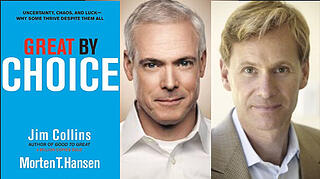Growth Insights for CEOs

5 AI Trends Every CEO Must Act On
Earlier this year, I shared takeaways from Mary Meeker’s Internet Trends Report, which showed how AI is reshaping business at a macro level. Building on that, Google Cloud’s 2025 AI Trends highlights five forces that will directly impact companies in the year ahead.
AI is no longer experimental. It is restructuring markets, reshaping customer expectations, and redrawing competitive boundaries. Here are five AI trends CEOs are preparing for now:
Recent Posts

Iterate to Target Rate: Digital Marketing Rewards Experimentation
Wed, Jul 11, 2012 — What does it mean to Iterate? Wikipedia defines it as "the act of repeating a process, usually with the aim of approaching a desired goal or target or result. Each repetition of the process is also called an 'iteration,' and the results of one iteration are used as the starting point for the next iteration."

#1 Way to Innovate: Execute
Thu, Jul 5, 2012 — As business leaders, we’re seduced into believing that innovation is the key to competitive advantage. How could anyone argue that an industry-changing product wouldn’t be a company’s ticket to leadership and success? Well, Jim Collins and Morten Hansen make a compelling and empirically-grounded counter argument in “Great By Choice”. Their 10X companies (those with substantially greater long term performance) are actually less innovative than their more innovative but less successful counterparts. Ultimately, it’s the company that “innovates” incrementally that is better prepared (and productively paranoid) that wins the day. The Cambridge Group has written fairly extensively on innovation. In their book “How Companies Win” Kash and Calhoun start with a compelling definition: “Innovation is finding unsatisfied profitable demand, then fulfilling it.” They go on to describe dimensions of Total Innovation: Invention New Product Innovation Product Enhancement Innovation Commercial (non-product) Innovation Operational Innovation Business Model Innovation

Rising Above Organic Growth
Sat, May 5, 2012 — A successful small to medium size business often runs the risk of feeling “too comfortable." Even though revenue is coming in, your customers like you, and your sales force is calling on customers regularly, you aren’t seeing the growth you are looking for. This lack of desired growth may be a result of new competitors, new products or services in the market, or that the market itself is growing stagnant. Get Outside Your Comfort Zone If any or all of these things are happening it should cause you to take a hard look at your business and consider going out of your comfort zone to continue to grow. It may be time to consider looking for new markets for your product. If you've grown comfortable selling to one or a few vertical markets, going beyond them may cause fundamental changes in your company. You may have to learn new industries, call on different kinds of buyers, and maybe have to recruit new sales people with knowledge of this new category. Market Expansion Most of all, you will have to take a hard look at your business and decide what kinds of problems you can be solving for new and different companies. Really getting into the guts of your business and looking beyond the obvious answers can sometimes be a painful exercise. You may be required to change the culture of your company in order to accommodate this new market opportunity that you have uncovered. But, the growth that comes with it is definitely worth the effort.
Stay up-to-date with the latest from Chief Outsiders
The Solution to Mediocre Marketing? A CMO Leading Multiple Niche Agencies
Thu, Apr 26, 2012 — It sounds like a great idea to turn your business's entire multichannel marketing campaign over to a single large marketing agency, doesn't it? You simply tell the agency, "Here's our target market, this is our brand, here's how we would like to position ourselves. Now go create the content, buy the media and help us grow." And the agency promotes itself as a "full-service" provider capable of handling every detail of your marketing from soup to nuts. So why are the results so frequently lackluster?
Too Broad a Brush: The Lack-of-Focus Problem
Wed, Apr 11, 2012 — Perhaps the most common issue I see among all kinds of businesses, from startups to large, established firms, is a lack of focus in their marketing. This generally takes the form of what I call taking too broad a brush to the market — throwing broad, scattershot strategies at the market in the hopes that some of it will stick, instead of pinpointing the most lucrative opportunities and then choosing the right applications — the right brush, if you will — to get the most of out those opportunities.

3 Steps to Improving Customer Retention
Wed, Mar 28, 2012 — As someone who once helped the pest control giant Terminix exterminate a nasty customer retention problem, I've seen what a difference a few strategic adjustments can make. So if you're facing the same issue, let me assure you that there are steps you can take to stamp it out.

Growth Opportunity: The Demand Chain
Mon, Mar 19, 2012 — Efficiency Only Goes So Far The last ten years of American business have been focused on integrating and perfecting operational efficiencies through the perfection and active management of the Supply Chain. For the last couple of years of economic turmoil, many companies have almost exclusively focused on supply chain efficiencies as a strategy for survival. Now the challenge is taking the expertise and company culture focused on linear thinking and introspection of the supply chain and start growing again.

New Twist to Executive Staffing: Think EaaS
Tue, Feb 14, 2012 — Executives for Rent While management consultants, marketing agencies and executive staffing have been around for decades, the notion of “hiring” just the amount of executive talent you need is something relatively new. It wasn’t until 1993 that John and Doug Tatum founded the firm that became synonymous with fractional CFOs. Their part-time executives join companies that can’t justify a full-time chief financial officer. Over time, Tatum grew to offer CIOs, COOs, and other “Os”. Jim McBride, senior managing member of Blue Sage Capital here in Austin, TX, once said to me, “if one of our companies needs a CFO, I know I can pick up the phone, call Tatum, and it’s done.” Great Idea for Marketing Execs Clearly, our firm Chief Outsiders is fashioned after this model. We see a growing demand for part-time or interim chief marketing officers. We’re even running ads now that say, “Why Hire a CMO?…When You Can Rent One, Fast.” So what’s all this about? Is this new model for executive staffing here to stay? We certainly think so. In some ways, it was inevitable. It’s even similar to shifts in other markets, including how people access technology services.

Marketing vs. Sales: Turning Antagonism into Alliance
Wed, Feb 8, 2012 —
.png?width=1500&height=398&name=CO_Corporate%20Logo%202021_4C_HOR_FNL-1%20(1).png)